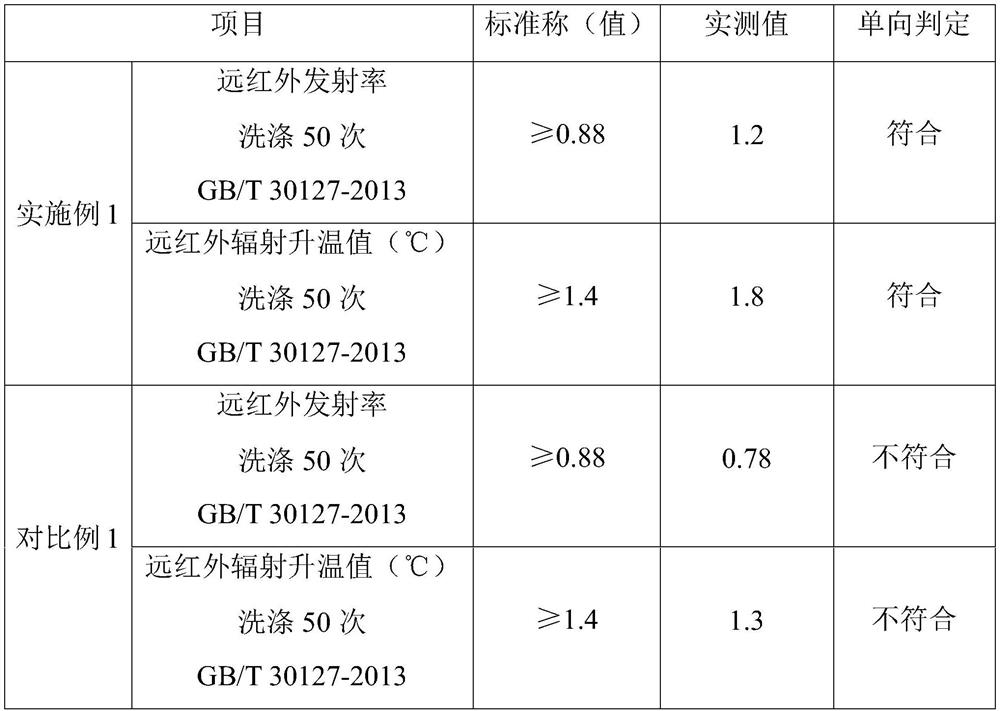Fabric capable of releasing far infrared rays and far infrared ray physiotherapy clothes
A technology of far-infrared rays and far-infrared negative ions, which is applied in the field of fabrics and far-infrared physiotherapy clothing, can solve the problems of reduced far-infrared emission and low emissivity, and achieve the effect of improving waterproof performance, good ventilation effect, and long-lasting emission effect
- Summary
- Abstract
- Description
- Claims
- Application Information
AI Technical Summary
Problems solved by technology
Method used
Image
Examples
Embodiment 1
[0029]A fabric capable of releasing far-infrared rays, comprising a TPU film layer 3, a first adhesive layer 4 arranged on the lower surface of the TPU film layer 3, and a far-infrared composite layer arranged on the lower surface of the first adhesive layer 4 5. The second adhesive layer 2 arranged on the upper surface of the TPU film layer 3, and the outer layer high elastic textile cloth 1 arranged on the upper surface of the second adhesive layer 2, the far-infrared composite layer 5 includes The far-infrared knitted fabric and the negative ion fiber layer, the negative ion fiber layer is arranged on the lower surface of the first adhesive layer 4, and the far-infrared knitted fabric is arranged on the lower surface of the negative ion fiber layer; the far-infrared knitted fabric and The surface of the negative ion fiber layer is all sprayed with a far-infrared negative ion adhesive layer; the TPU film layer 3 is provided with several evenly distributed ventilation holes; t...
Embodiment 2
[0043] The difference between this embodiment and Embodiment 1 is:
[0044] The far-infrared negative ion adhesive layer is formed by spraying the far-infrared negative ion adhesive, and the far-infrared negative ion adhesive includes the following raw materials by weight: 13 parts of far-infrared nano-ceramic powder, 1.5 parts of negative ion additives, 6 parts of adhesive, cross-linking 0.7 parts of the agent, 2 parts of softener, 1.5 parts of polyvinyl alcohol and 38 parts of deionized water; the far-infrared nano-ceramic powder is the far-infrared nano-ceramic powder produced by Dongguan Yanteng Negative Ion Technology Co., Ltd., and the softener is Shandong Polyethylene Softener produced by Neng Chemical Co., Ltd.
[0045] The adhesive comprises the following raw materials by weight: 12 parts of ethylene-acrylic acid copolymer, 12 parts of epoxy resin, 2 parts of chitosan, 5 parts of polyacrylate, 13 parts of phase change microcapsules and ethylene-vinyl acetate copolymer...
Embodiment 3
[0059] The difference between this embodiment and Embodiment 1 is:
[0060] The far-infrared negative ion glue layer is sprayed with far-infrared negative ion glue, and the far-infrared negative ion glue includes the following raw materials by weight: 15 parts of far-infrared nano-ceramic powder, 2 parts of negative ion additives, 8 parts of adhesive, cross-linking 0.8 parts of agent, 3 parts of softener, 2 parts of polyvinyl alcohol and 45 parts of deionized water; the far-infrared nano-ceramic powder adopts far-infrared nano-ceramic powder produced by Dongguan Yanteng Negative Ion Technology Co., Ltd., and the softener adopts Shandong Polyethylene Softener produced by Neng Chemical Co., Ltd.
[0061] The adhesive comprises the following raw materials by weight: 13 parts of ethylene-acrylic acid copolymer, 13 parts of epoxy resin, 3 parts of chitosan, 6 parts of polyacrylate, 15 parts of phase change microcapsules and ethylene-vinyl acetate copolymer 2 parts; ethylene-acryli...
PUM
 Login to View More
Login to View More Abstract
Description
Claims
Application Information
 Login to View More
Login to View More - R&D
- Intellectual Property
- Life Sciences
- Materials
- Tech Scout
- Unparalleled Data Quality
- Higher Quality Content
- 60% Fewer Hallucinations
Browse by: Latest US Patents, China's latest patents, Technical Efficacy Thesaurus, Application Domain, Technology Topic, Popular Technical Reports.
© 2025 PatSnap. All rights reserved.Legal|Privacy policy|Modern Slavery Act Transparency Statement|Sitemap|About US| Contact US: help@patsnap.com


